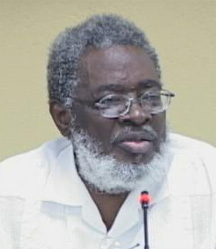Dr Roger Luncheon yesterday admitted that government had rejected the contents of a feasibility report and eventually sited the Berbice River Bridge at Palmyra—a largely Indian-Guyanese populated village—but he denied that there was any attempt to deprive other areas as a result.
In testimony under cross-examination in the $10 million libel case brought by President Bharrat Jagdeo against Kaieteur News and columnist Freddie Kissoon, Luncheon said that US-based company Figg Engineering Inc conducted one of the first feasibility studies on the location of the bridge, but he could not recall whether it was a pre-feasibility study or feasibility study. “I know it was one or the other,” he said in response to a question posed by defence attorney Nigel Hughes. He added that either five or six such studies were done.
According to Luncheon, who is Head of the Presidential Secretariat, Cabinet deliberated on the Figg report but he could not recall whether it had outlined the least costly option for the site of the bridge—upstream from the largely African-Guyanese populated Everton.

Luncheon added that bridge’s present location, at Palmyra, bypasses all villages between New Amster-dam and Everton, but he added that he could not definitively say that African Guyanese populated those areas. When asked by Hughes if he agreed that the operation of the bridge and the attendant ending of the ferry service affected the economic well-being of New Amsterdam, he, however, said: “I am not aware of the ferry service ceasing. I am aware that there was a relationship between the service and the economic activity of the township of New Amsterdam.”
Although Luncheon said the feasibility studies did consider the economic impact on the site for the bridge, he did not accept the suggestion by Hughes that Cabinet specifically considered the economic aspect of not placing the bridge anywhere south of Everton. “A final decision was made contrary to the recommendations of the Figg group,” he noted, when asked if the decision to put the bridge at Palmyra was in opposition to the Figg report.
He said the decision on the final site for the bridge was based on several considerations, but he was uncertain which engineer’s report influenced Cabinet’s decision on the final location. He added that it was not only based on the engineer’s report and said that it probably came from “our own engineering work service group,” headed by Prime Minister Samuel Hinds.
‘King Kong’ revisited
Luncheon also faced more questions about Guyanese political folklore and the attributes associated with the term ‘King Kong.’
The libel suit was prompted by a June 28, 2010 Kissoon article, titled ‘King Kong sent his goons to disrupt the conference’ and the defence is seeking to justify its portrayal of Jagdeo as an ideological racist who heads a government that practices racism. Kaieteur News columnist Kissoon, Kaieteur News Editor Adam Harris and the National Media and Publishing Company Ltd, the newspaper’s publisher, are the defendants in the suit.
According to Luncheon, he would not associate the term with an unpleasant looking person, a caveman or someone with goons, but rather with someone who is violent. He said he did not view ‘King Kong’ as particularly someone who ruled his domain; a king-of-the-jungle type of figure.
Anil Nandlall, the lead lawyer for Jagdeo’s legal team, minutes later objected, saying that he did not think that the witness had expansive knowledge of folklore and asked that the questioning be confined to political folk lore. Justice Brassington Reynolds, who is presiding over the case, however, overruled his objection and permitted Luncheon to respond to the questions arising.
Luncheon told the court that he was not aware of the structured form of political folklore and was not aware that ‘King Kong’ had any adversaries in the Guyanese folklore but knew that there were victims, and among them were the PPP, WPA, UF and members of the civil society, including the bar association and religious bodies. He said he could not identify an individual who grabbed the attention of ‘King Kong.’ Asked to describe the ‘King Kong-type’ of attention, he listed “aggression, public diatribes and threats.”
Turning his line of questioning to the article that sparked the libel suit, Hughes referenced two specific paragraphs and asked Luncheon if ‘King Kong’ referred to anyone by name. He responded in the negative. He said it was his understanding that the author of the article was making comparisons between characters and racism, paying special attention to the presidencies of Forbes Burnham, Desmond Hoyte, Cheddi Jagan, Janet Jagan and Bharrat Jagdeo.
Among the author’s findings, he said, was the fact those with the exception of Hoyte played down to their respective ethnic constituencies. Luncheon also concluded that the author also found that the difference between the Jagdeo presidency and the others is that he exercised power driven by ideological racism. He acknowledged that the author of the article was an academic who lectures at the University of Guyana and noted that academics are allowed the freedom of research and to come to their own conclusions.
Additionally, Luncheon said he did not have information at his hand reach that the heads of the executive, the legislature and the judiciary were all of Indian descent, but noted that at the time of the publication Jagdeo, Speaker of the National Assembly Ralph Ramkarran and Head of the Judiciary Carl Singh were all Indo-Guyanese.
Luncheon, who is the first of Jagdeo’s witnesses and has been on the stand for several weeks, will continue to face cross-examination today.





